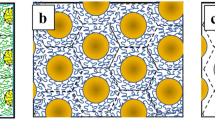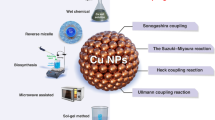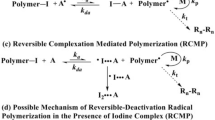Abstract
The optimization to achieve stable and high-yield gold nanoparticles in block copolymer-mediated synthesis has been examined. Gold nanoparticles are synthesized using block copolymer P85 in gold salt HAuCl4·3H2O solution. This method usually has a very limited yield which does not simply increase with the increase in the gold salt concentration. We show that the yield can be enhanced by increasing the block copolymer concentration but is limited to the factor by which the concentration is increased. On the other hand, the presence of an additional reductant (trisodium citrate) in 1:1 molar ratio with gold salt enhances the yield by manyfold. In this case (with additional reductant), the stable and high-yield nanoparticles having size about 14 nm can be synthesized at very low block copolymer concentrations. These nanoparticles thus can be efficiently used for their application such as for adsorption of proteins.








Similar content being viewed by others
References
Alexandridis P (2011) Gold nanoparticle synthesis, morphology control, and stabilization facilitated by functional polymers. Chem Eng Technol 34:15–28
Alexandridis P, Lindman B (2000) Amphiphilic block copolymers: self-assembly and applications. Elsevier, Amsterdam
Alexandridis P, Holzwarth JF, Hatton TA (1994) Micellization of poly(ethylene oxide)–poly(propylene oxide)–poly(ethylene oxide) triblock copolymers in aqueous solutions: thermodynamics of copolymer association. Macromolecules 27:2414–2425
Bakshi MS, Kaura A, Bhandari P, Kaur G, Torigoe K, Esumi K (2006) Synthesis of colloidal gold nanoparticles of different morphologies in the presence of triblock polymer micelles. J Nanosci Nanotechnol 6:1405–1410
Daniel MC, Astruc D (2004) Gold nanoparticles: assembly, supramolecular chemistry, quantum-size-related properties, and applications toward biology, catalysis, and nanotechnology. Chem Rev 104:293–346
Debye P (1947) Molecular-weight determination by light scattering. J Phys Colloid Chem 51:18–32
Hayter JB, Penfold J (1983) Determination of micelle structure and charge by neutron small-angle scattering. Colloid Polym Sci 261:1022–1030
Keiderling U (2002) The new ‘BerSANS-PC’ software for reduction and treatment of small angle neutron scattering data. Appl Phys A Mater Sci Process 74:S1455–S1457
Khullar P, Mahal A, Singh V, Banipal TS, Kaur G, Bakshi MS (2010) How PEO–PPO–PEO triblock polymer micelles control the synthesis of gold nanoparticles: temperature and hydrophobic effects. Langmuir 26:11363–11371
Kumar S, Aaron J, Sokolov K (2008) Directional conjugation of antibodies to nanoparticles for synthesis of multiplexed optical contrast agents with both delivery and targeting moieties. Nat Protoco 3:314–320
Liz-Marzan LM (2006) Tailoring surface plasmons through the morphology and assembly of metal nanoparticles. Langmuir 22:32–41
Nghiem THL, La TH, Vu XH, Chu VH, Nguyen TH, Le QH, Fort E, Do QH, Tran HN (2010) Synthesis, capping and binding of colloidal gold nanoparticles to proteins. Adv Nat Sci Nanosci Nanotechnol 1:025009
Pedersen JS (2000) Form factors of block copolymer micelles with spherical, ellipsoidal and cylindrical cores. J Appl Crystallogr 33:637–640
Ray D, Aswal VK (2010) Step-addition method for enhancing the yield of gold nanoparticles in block copolymer solution. J Macromol Sci Part B Phys 49:810–820
Ray D, Aswal VK (2011a) Multi-technique approach for the study of block copolymer-mediated gold nanoparticles. Nanosci Nanotechnol Lett 3:603–611
Ray D, Aswal VK (2011b) Tuning of block copolymer-mediated synthesis of gold nanoparticles. Int J Nanosci 10:1035–1038
Ray D, Aswal VK, Srivastava D (2010) Concentration effect on tuning of block copolymer-mediated synthesis of gold nanoparticles. J Nanosci Nanotechnol 10:6356–6362
Ray D, Aswal VK, Kohlbrecher J (2011a) Synthesis and characterization of high concentration block copolymer-mediated gold nanoparticles. Langmuir 27:4048–4056
Ray D, Aswal VK, Srivastava D (2011b) Correlating self-assembly of block copolymers for their application in synthesis of gold nanoparticles. J Nanosci Nanotechnol 11:1905–1913
Sakai T, Alexandridis P (2004) Single-step synthesis and stabilization of metal nanoparticles in aqueous pluronic block copolymer solutions at ambient temperature. Langmuir 20:8426–8430
Sakai T, Alexandridis P (2005a) Mechanism of gold metal ion reduction, nanoparticle growth and size control in aqueous amphiphilic block copolymer solutions at ambient conditions. J Phys Chem B 109:7766–7777
Sakai T, Alexandridis P (2005b) Size- and shape-controlled synthesis of colloidal gold through autoreduction of the auric cation by poly(ethylene oxide)–poly(propylene oxide) block copolymers in aqueous solutions at ambient conditions. Nanotechnology 16:S344–S353
Sardar R, Funston AM, Mulvaney P, Murray RW (2009) Gold nanoparticles: past, present, and future. Langmuir 25:13840–13851
Sommer WJ, Weck M (2007) Facile functionalization of gold nanoparticles via microwave-assisted 1,3 dipolar cycloaddition. Langmuir 23:11991–11995
Vaidyanathan R, Gopalram S, Kalishwaralal K, Deepak V, Pandian SRK, Gurunathan S (2010) Enhanced silver nanoparticle synthesis by optimization of nitrate reductase activity. Colloids Surf B 75:335–341
Xu X, Rosi NL, Wang Y, Huo F, Mirkin CA (2006) Asymmetric functionalization of gold nanoparticles with oligonucleotides. J Am Chem Soc 128:9286–9287
Acknowledgments
The authors would like to acknowledge Dr. U. Gasser and Dr. J. Kohlbrecher for their support during SANS measurements, Ms. S. Kanungo and Prof. J. Bellare for TEM micrographs, and Dr. P. A. Hassan and Dr. G. Verma for zeta potential measurements.
Author information
Authors and Affiliations
Corresponding author
Rights and permissions
About this article
Cite this article
Ray, D., Aswal, V.K. Optimization of components in high-yield synthesis of block copolymer-mediated gold nanoparticles. J Nanopart Res 14, 778 (2012). https://doi.org/10.1007/s11051-012-0778-8
Received:
Accepted:
Published:
DOI: https://doi.org/10.1007/s11051-012-0778-8




